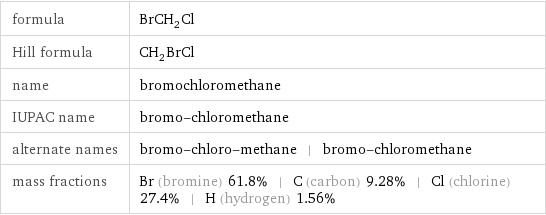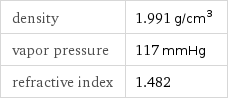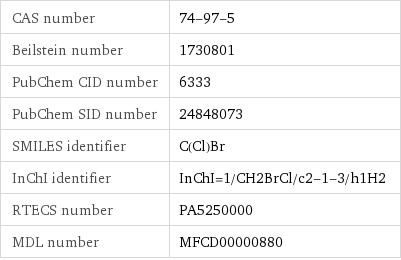Input interpretation

bromochloromethane
Chemical names and formulas

formula | BrCH_2Cl Hill formula | CH_2BrCl name | bromochloromethane IUPAC name | bromo-chloromethane alternate names | bromo-chloro-methane | bromo-chloromethane mass fractions | Br (bromine) 61.8% | C (carbon) 9.28% | Cl (chlorine) 27.4% | H (hydrogen) 1.56%
Lewis structure

Draw the Lewis structure of bromochloromethane. Start by drawing the overall structure of the molecule: Count the total valence electrons of the bromine (n_Br, val = 7), carbon (n_C, val = 4), chlorine (n_Cl, val = 7), and hydrogen (n_H, val = 1) atoms: n_Br, val + n_C, val + n_Cl, val + 2 n_H, val = 20 Calculate the number of electrons needed to completely fill the valence shells for bromine (n_Br, full = 8), carbon (n_C, full = 8), chlorine (n_Cl, full = 8), and hydrogen (n_H, full = 2): n_Br, full + n_C, full + n_Cl, full + 2 n_H, full = 28 Subtracting these two numbers shows that 28 - 20 = 8 bonding electrons are needed. Each bond has two electrons, so the above diagram has all the necessary bonds. There are 4 bonds and hence 8 bonding electrons in the diagram. Lastly, fill in the remaining unbonded electrons on each atom. In total, there remain 20 - 8 = 12 electrons left to draw: Answer: | |
3D structure

3D structure
Basic properties

molar mass | 129.4 g/mol phase | liquid (at STP) melting point | -88 °C boiling point | 68 °C density | 1.991 g/cm^3
Units

Liquid properties (at STP)

density | 1.991 g/cm^3 vapor pressure | 117 mmHg refractive index | 1.482
Units

Thermodynamic properties

specific heat capacity c_p | gas | 0.4073 J/(g K) molar heat capacity c_p | gas | 52.7 J/(mol K) (at STP)
Chemical identifiers

CAS number | 74-97-5 Beilstein number | 1730801 PubChem CID number | 6333 PubChem SID number | 24848073 SMILES identifier | C(Cl)Br InChI identifier | InChI=1/CH2BrCl/c2-1-3/h1H2 RTECS number | PA5250000 MDL number | MFCD00000880
Toxicity properties

threshold limit value | 200 ppmv
Units
